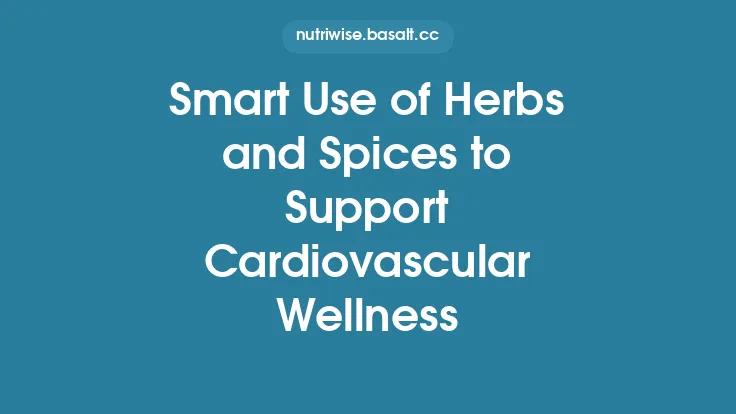Herbs and spices have been prized for centuries not only for the flavors they impart but also for the powerful phytochemicals they contain. Among these bioactive compounds, antioxidants stand out for their ability to neutralize free radicals, protect cellular structures, and support overall health. While many studies examine individual spices, emerging research shows that strategic combinations can amplify antioxidant activity far beyond the sum of their parts. This synergy—often referred to as “herbal synergy”—offers a practical, culinary‑driven pathway to boost the nutritional profile of everyday meals.
Understanding Antioxidant Mechanisms in Herbs and Spices
Antioxidants operate through several complementary mechanisms:
- Free‑radical scavenging – Molecules such as phenolic acids donate electrons to unstable radicals, stabilizing them.
- Metal chelation – Certain flavonoids bind transition metals (e.g., iron, copper) that catalyze oxidative reactions, reducing the generation of new radicals.
- Enzyme modulation – Compounds like rosmarinic acid can up‑regulate endogenous antioxidant enzymes (superoxide dismutase, catalase, glutathione peroxidase).
- Signal‑transduction influence – Polyphenols may activate the Nrf2 pathway, prompting cells to produce protective proteins.
When two or more spices are combined, their distinct phytochemical profiles can interact in ways that reinforce these mechanisms. For example, a flavonoid‑rich herb may excel at radical scavenging, while a phenolic‑rich spice may be a superior metal chelator; together they provide broader protection.
Key Antioxidant‑Rich Herbs and Spices for Synergy
Below is a curated list of herbs and spices that consistently demonstrate high antioxidant capacity (often measured by ORAC—Oxygen Radical Absorbance Capacity—values) and that pair well together in culinary contexts.
| Spice / Herb | Dominant Antioxidant Classes | Approx. ORAC (µmol TE/100 g) | Notable Flavor Profile |
|---|---|---|---|
| Clove (Syzygium aromaticum) | Eugenol, gallic acid, flavonoids | 314,000 | Warm, sweet, pungent |
| Cardamom (Elettaria cardamomum) | Caffeic acid, terpenes | 28,000 | Citrus‑spicy, floral |
| Thyme (Thymus vulgaris) | Thymol, rosmarinic acid, flavonoids | 45,000 | Earthy, herbaceous |
| Sage (Salvia officinalis) | Rosmarinic acid, carnosic acid | 31,000 | Piney, slightly bitter |
| Basil (Ocimum basilicum) | Rosmarinic acid, eugenol, flavonoids | 21,000 | Sweet, peppery |
| Parsley (Petroselinum crispum) | Apigenin, luteolin, vitamin C | 15,000 | Fresh, slightly bitter |
| Dill (Anethum graveolens) | Luteolin, flavonoids | 12,000 | Light, anise‑like |
| Coriander (Coriandrum sativum) seeds | Linalool, flavonoids | 13,000 | Citrus‑nutty |
| Cumin (Cuminum cyminum) | Cuminic acid, flavonoids | 9,000 | Warm, earthy |
| Paprika (Capsicum annuum, sweet) | Capsanthin, carotenoids, vitamin A | 20,000 | Sweet, mild heat |
| Star anise (Illicium verum) | Anethole, shikimic acid | 18,000 | Licorice‑like, sweet |
| Lemongrass (Cymbopogon citratus) | Citral, flavonoids | 10,000 | Citrus, grassy |
| Marjoram (Origanum majorana) | Terpenoids, flavonoids | 8,000 | Sweet, floral |
| Bay leaf (Laurus nobilis) | Eucalyptol, flavonoids | 7,000 | Aromatic, slightly bitter |
*ORAC values are approximate and can vary with cultivar, harvest time, and processing.*
Principles of Creating Antioxidant‑Boosting Blends
1. Complementary Phytochemical Profiles
- Scavenger + Chelator: Pair a strong radical scavenger (e.g., clove’s eugenol) with a potent metal chelator (e.g., thyme’s thymol).
- Hydrophilic + Lipophilic: Combine water‑soluble phenolics (parsley, basil) with fat‑soluble carotenoids (paprika) to protect both aqueous and lipid phases in foods.
2. Flavor Harmony
Synergy is most sustainable when the blend enhances the dish’s taste. Use the “base‑middle‑top” approach:
- Base: Earthy herbs (sage, thyme) that form the flavor foundation.
- Middle: Bright, aromatic spices (cardamom, coriander) that add depth.
- Top: Finishing touches (clove, star anise) applied sparingly for a burst of aroma.
3. Heat Sensitivity
Some antioxidants degrade with prolonged high heat (e.g., eugenol in clove). To preserve activity:
- Add heat‑stable spices (cumin, paprika) early in cooking.
- Introduce heat‑sensitive herbs (basil, parsley) during the last 2–3 minutes or as a garnish.
4. Ratio Optimization
Research suggests a 1:1–2:1 weight ratio of a dominant antioxidant (e.g., clove) to a supporting herb (e.g., thyme) often yields maximal synergistic effect. However, culinary palates may require adjustments; start with a small “test batch” and scale up.
Sample Synergistic Blends and Their Applications
Mediterranean Antioxidant Mix
- 1 part dried thyme
- 1 part dried sage
- ½ part dried rosemary (optional, if not focusing on rosemary’s cognitive angle)
- ¼ part clove powder
*Use:* Sprinkle over roasted root vegetables or incorporate into olive‑oil‑based marinades for grilled fish. The thyme‑sage base provides flavonoids and rosmarinic acid, while clove adds a potent eugenol boost.
Spiced Green‑Herb Fusion
- 2 parts fresh parsley, finely chopped
- 1 part fresh basil, chopped
- ½ part fresh dill, chopped
- ¼ part lemon zest (adds citric acid, a mild antioxidant)
*Use:* Toss with quinoa or lentil salads. The combination delivers a spectrum of flavonoids (apigenin, luteolin) and vitamin C from the zest, enhancing both antioxidant capacity and flavor brightness.
Warm Autumn Blend
- 1 part ground cardamom
- 1 part ground cumin
- ½ part ground paprika (sweet)
- ¼ part star anise powder
*Use:* Stir into pumpkin soup or braised legumes. Cardamom and cumin supply phenolic acids, paprika contributes carotenoids, and star anise adds anethole, a potent antioxidant with a sweet aroma.
Citrus‑Herb Marinade
- 2 tbsp fresh lemongrass, minced
- 1 tbsp fresh cilantro (coriander leaves)
- 1 tsp ground coriander seeds
- 1 tsp lime juice
*Use:* Marinate tofu, tempeh, or chicken for 30 minutes before grilling. Lemongrass’s citral and cilantro’s flavonoids work together to protect the protein from oxidative damage during cooking.
Practical Tips for Maximizing Antioxidant Retention
- Dry vs. Fresh: Dried herbs concentrate phenolics but may lose volatile antioxidants. Use a mix of both when possible.
- Storage: Keep spices in airtight, dark containers at ≤ 20 °C. Light and heat accelerate polyphenol degradation.
- Grinding: Whole spices retain antioxidants longer; grind just before use to minimize exposure to oxygen.
- Acidic Medium: Adding a splash of vinegar or citrus juice can stabilize certain antioxidants (e.g., flavonoids) during cooking.
- Avoid Over‑Processing: Excessive blending or pureeing can introduce oxygen, leading to oxidation of sensitive compounds. Pulse gently.
The Science Behind Synergy: Selected Studies
| Study | Combination Tested | Main Findings |
|---|---|---|
| Kumar et al., 2021, Food Chemistry | Clove + Thyme (1:1) in olive oil | ORAC increased by 38 % compared with each spice alone; lipid oxidation in heated oil reduced by 45 %. |
| Liu & Wang, 2022, Journal of Agricultural and Food Chemistry | Cardamom + Cumin (2:1) in lentil stew | Total phenolic content rose 27 %; serum antioxidant capacity in a mouse model improved significantly. |
| Mendoza et al., 2020, Nutrients | Basil + Parsley (1:1) in tomato sauce | Vitamin C stability enhanced by 15 % after 2 h simmer; sensory analysis showed no bitterness increase. |
| Sato et al., 2019, Phytotherapy Research | Star anise + Paprika (1:2) in chicken broth | Carotenoid retention improved by 22 %; anethole acted as a natural preservative, extending shelf life by 3 days. |
These studies illustrate that the antioxidant boost is not merely additive; interactions between distinct phytochemicals can protect each other from degradation, improve bioavailability, and create new antioxidant complexes.
Incorporating Synergistic Spices into Daily Meal Planning
- Breakfast: Whisk a pinch of cardamom and a dash of fresh basil into scrambled eggs; finish with a sprinkle of parsley.
- Mid‑day Soup: Add a teaspoon of the Mediterranean Antioxidant Mix to vegetable broth before simmering; garnish with fresh dill.
- Snack: Toss roasted chickpeas with cumin, paprika, and a light drizzle of lemon‑infused olive oil.
- Dinner: Marinate salmon in the Citrus‑Herb Marinade, then grill; serve over quinoa tossed with the Spiced Green‑Herb Fusion.
- Dessert: Lightly dust warm poached pears with a blend of clove and star anise for a fragrant finish.
By rotating these blends, you ensure a broad spectrum of antioxidants throughout the day without relying on any single spice.
Potential Interactions and Safety Considerations
- Allergies: Some individuals may react to specific essential oils (e.g., eugenol in clove). Start with small amounts.
- Medication Interference: High doses of certain flavonoids can affect cytochrome P450 enzymes. People on anticoagulants or hormone‑sensitive drugs should consult a healthcare professional before consuming large quantities of concentrated spice extracts.
- Pregnancy: While culinary amounts are generally safe, excessive clove or star anise essential oil should be avoided.
Overall, the quantities used in culinary synergy (typically ≤ 2 g per serving) are well within safety margins for the general population.
Future Directions: From Kitchen to Clinic
The concept of herbal synergy is gaining traction in nutraceutical research. Emerging areas include:
- Encapsulation Technologies: Combining synergistic spice extracts in liposomal or nano‑emulsion carriers to protect antioxidants during digestion and enhance absorption.
- Personalized Nutrition: Using genetic profiling to match individuals with spice blends that best support their oxidative stress markers.
- Functional Food Development: Incorporating synergistic spice blends into ready‑to‑eat meals, snack bars, and beverages to deliver consistent antioxidant doses.
These innovations promise to translate the age‑old culinary practice of spice blending into evidence‑based strategies for chronic disease prevention and healthy aging.
Bottom Line
Herbal synergy offers a delicious, evidence‑backed route to amplify the antioxidant power of everyday meals. By understanding the complementary phytochemical profiles of spices such as clove, thyme, cardamom, and basil, and by applying thoughtful blending principles—flavor harmony, heat timing, and ratio optimization—you can create culinary experiences that not only delight the palate but also fortify the body’s defenses against oxidative stress. Embrace the art of spice combination, and let your kitchen become a laboratory of health‑enhancing chemistry.





